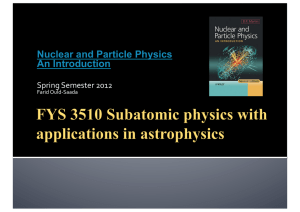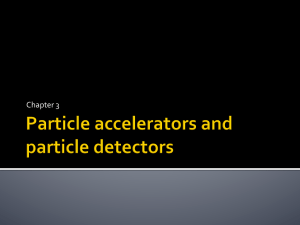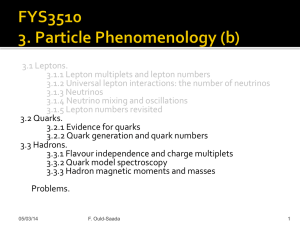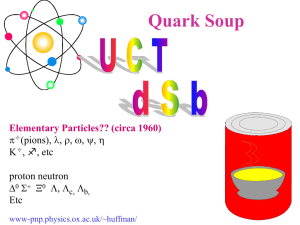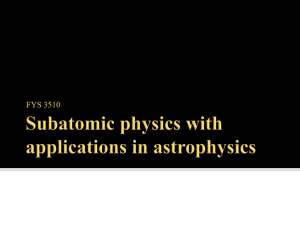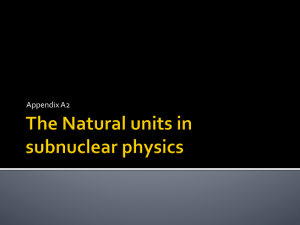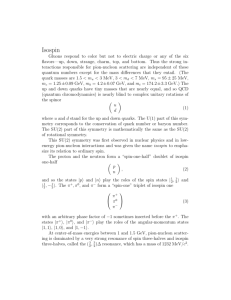Chapter 7
advertisement
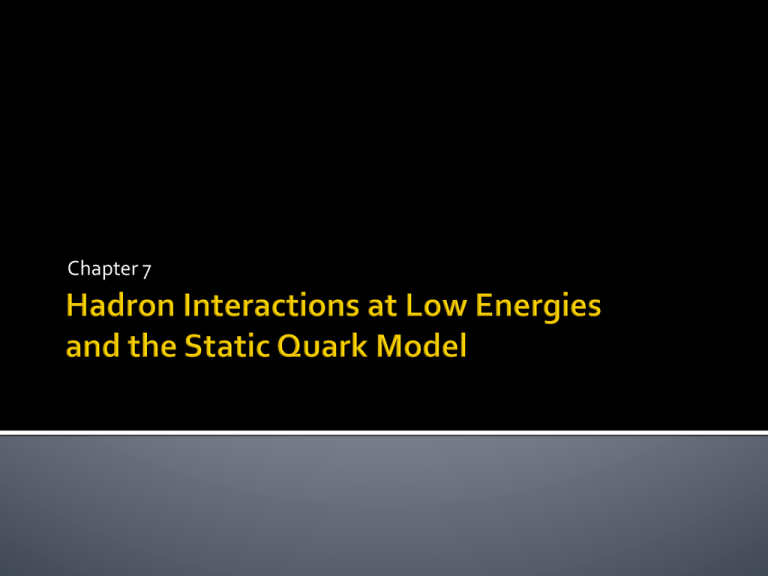
Chapter7 ¡ 7.1HadronsandQuarks § ¡ ¡ 7.2Proton-NeutronSymmetryandtheIsotopicSpin 7.3TheStrongInteractionCross-Section § ¡ § 7.5.1The_CC.1232/Resonance 7.5.2ResonanceFormationandProduction 7.5.3AngularDistributionofResonanceDecayProducts 7.8.1FirstIndicationsfortheColorQuantumNumber 7.9TheJP=1/2CBaryonicOctet 7.10PseudoscalarMesons 7.11TheVectorMesons 7.12StrangenessandIsospinConservation 7.13TheSixQuarks 7.14ExperimentalTestsontheStaticQuarkModel § § ¡ 7.4.2HadronResonances 7.6ProductionandDecayofStrangeParticles 7.7ClassificationofHadronsMadeofu;d;sQuarks 7.8TheJP=3/2CBaryonicDecuplet § ¡ ¡ ¡ ¡ 7.4.1Antibaryons 7.5Breit–WignerEquationforResonances § ¡ ¡ ¡ 7.3.1MeanFreePath 7.4LowEnergyHadron-HadronCollisions § ¡ 7.1.1TheYukawaModel 7.14.1LeptonicDecaysofNeutralVectorMesons 7.14.2LeptonPairProduction 7.14.3Hadron-HadronCross-SectionsatHighEnergies7.14.4BaryonMagneticMoments 7.14.5RelationsBetweenMasses 7.15SearchesforFreeQuarksandLimitsoftheModel 2 ¡ Ahadronismadeofquarksandhasdimensions~1fm § Mesons–hadronswithintegerspin § Baryons–semi-integerspin § Hyperonsare“strange”baryons,i.e.,composedofatleastonesquark. ¡ Hadron“spectroscopy” § canbeexplainedusingthesimplestaticquarkmodelofhadrons ¡ Constituentquarks–valencequarks– § explaintheregularitiesofthehadronspectra § Quarkswerefirstmathematicalfictionasnofreequarkshaveeverbeen observed. ¡ Evidenceforquarks § lepton-hadroncollisionswithhightransferredmomentum ¡ Deepinelasticscatteringexperiments § hadronsalsocontaingluonsandvirtualqqbarpairs(seaquarks),rapidly createdandannihilated 07/03/16 F. Ould-Saada 3 ¡ 1stattempttoexplaininteractionbetweennucleonsinnuclei § quantummechanicalmodel–Yukawa1930s. ▪ InanalogywithQED–exchangeofmasslessγ,potentialV~1/r ▪ Strongforces–maximumrange~1fm,exchangebosonmustbeheavy~150MeV ▪ SochangeQEDpotentialsuchthatititquicklyvanisheswithdistanceduetoexchangeof massiveparticles !2 2 2 2 4 % E =m c +p c ' * 1 ∂2 " 2 - m 2 c 2 " ⇒ , 2 2 22 −2 ∇ !/φ + 2 2 4 φ != 0 ∂ " 2 ∂2ϕ"(r,& t) ¡ Klein-Gordonequation c ∂t c ∇ ϕ (r,.t) + m!c ϕ (r, t) E →ih ; p −! →− ih∇2' =+−! ( ∂t ∂t § E,p,mrelation r 2 2 − m c K 2 a § Correspondenceprinciple ∇ ϕ = 2 ϕ ⇒ ϕ = e ! r § φinterpretedaspotentialUincoordinate space § staticpotentialU(r) 07/03/16 F. Ould-Saada 4 ! m2c2 1 ∂ % ∂U ( 2 φ (r, t) → U(r) ⇒ ∇ U = 2 U = 2 ' r 2 * & " r ∂r ∂r ) ¡ g 1 −r/R ! e ; R = 4π r mc !c 2 R ≈ 1.2fm ⇒ mc = ≈ 150MeV ≈ mπ R U(r) = Huntingafterameson(me<mπ<mp)opened § 3chargestatestoaccommodatepp,pn,nninteractions ¡ Wasbelievedthatthemuonfoundincosmicrayswasthepion § MuoncannotbeYukawa’smeson…doesnotinteractstrongly! § Pionsdiscoveredlater… 07/03/16 F. Ould-Saada 5 ¡ Heisenberg,1932 § Neutron&protonastwostatesofasingle particle,thenucleonN,withrespectto stronginteractions § Analogywithspin,isospinofN:I=1/2 ▪ pandnareeigenstatesofI3 § StronginteractiondependsonI,notonI3 ▪ I3behavesas“Q” Nucleon ≡ N ≡ (np) ; I = p ≡ 1 1 ,+ 2 2 ▪ EMconservesI3 07/03/16 F. Ould-Saada 1 1 ,− 2 2 ≡(10) Proton and neutron are eigenstates of I 3 I 3 p = + 12 p ; I 3 n = − 12 n § Isopinnotconservedindecaysinducedby weakandEMinteractions ≡ (10) ; n ≡ 1 2 Ii = σi 2 ! ⎛ I1 ⎞ ; I = ⎜ I2 ⎟ ∈ ⎝ I3 ⎠ Isospinspace 6 Isospinhassamemathematicalbehaviourasspin ¡ § Spinisaphysicalquantity ▪ measuredinunitsofh ▪ withdimensionofEnergy.Time § Isospinisadimensionlessquantity ▪ helpsclassifyinghadronsintomultiplets Ii = σi 2 ! ! I1 $ ; I = # I2 & ∈ " I3 % σ 1 = (10 01) ; σ 2 = (i0 Ladder operators: transformations p ↔ n I + ≡ I1 + iI 2 = (00 10) ; I − ≡ I1 − iI 2 = (10 00) Isospinspace ) ; σ = ( ) ; 1= ( ) −i 0 3 1 0 0 −1 1 0 0 1 I12 + I 22 + I 32 = I 2 → eigenvalues I(I +1) I = 0,1 / 2,1, 3 / 2,... −I ≤ I 3 ≤ I → multiplet (2I +1) 07/03/16 F. Ould-Saada 7 ¡ ConservationofI § ConnectedtoobservationthatnuclearstateswithsameN(nucleons) butdifferentN(protons)havesameenergy,spinandparity. ¡ InvarianceoftheHamiltonianofnuclearinteractions § =nuclearinteractionindependencefromtheelectriccharge ¡ Groundstatesof7Beand7LihavesameE,s,P § 7Be(I3=+1/2):pppair;7Li(I3=-1/2):nnpair ▪ ExcludingEMeffects,impliestheequalityofforcesbetweenthennandpp pairs 07/03/16 F. Ould-Saada 8 ¡ NucleiwithA=14haveJP=0+andnearlysameenergy: § 14C(I3=-1)):nnpair § 14N(I3=0)):nppair § 14O(I3=+1)):pppair § ¡ Reactionprohibitedinstronginteractionsandallowedfor EMinteraction 4 0 d + d → He + π I 0 0 0 1 ← I not conserved I 3 0 0 0 0 ← I 3 conserved ▪ ProcessmustproceedwithcrosssectionstypicalofEM ▪ Confirmedthatcrosssectionis100timessmallerthantypicalstrongcross sections 07/03/16 F. Ould-Saada 9 ¡ Mirrornuclei:samevalueofAbutvaluesof NandZinterchanged B ( A = 11, Z = 5, N = 6 ) ! # 10 pp,15nn pairs # " same np − pairs 11 6 C ( A = 11, Z = 6, N = 5)# # 15pp,10 nn pairs $ 11 5 ¡ ¡ Chargesymmetryapproximatelyverifiedà Ifdifferentnp-pairs,effectduetofactthat nppairnotsubjecttoPauliprinciple § testofchargeindependence ¡ 11 5 B , 116C , 114Be Butevidencethatstrongforcestrongerfor S=1thanS=0state 07/03/16 F. Ould-Saada Lowlyingenergylevelsofmirrornuclei 10 ¡ 2-dimensionalspacerepresentation ¡ § Nucleon:(p,n)orquarks(u,d):I=1/2 § Generatorsare2x2Paulimatrices ¡ 4-dimensionalspacerepresentation Δ(1232):I=3/2àI3=3/2,1/2,-1/2,-3/2 § Basis(Δ++,Δ-,Δ0,Δ-) § 3-dimensionalspacerepresentation § Basis:(π+, π0, π-)withisospinI=1andI3=+1,0,-1 § Generatorsare3x3matrices ¡ ConservationofIsospininSI § SIdependsonlyonIandisindependentonI3andQ Q = I3 + § TotalIisconservedinSI B 2 § àselectionrulesandpreciserelationbetweenproductioncrosssectionsofrelatedprocesses p + p → d + π + I 1!" / 2 1# / 2 0 1 ! # $ 1 1 07/03/16 p + n → d + π 0 I 1!" / 2 1# / 2 0 1 ! # $ 1 0,1 F. Ould-Saada σ ( pp → d π + ) σ ( pn → d π 0 ) =2 11 ¡ Chargemultiplets: § Particles~samemass,samequantumnumbers(J,C,P,B,S,C,B’,...)but differentQ § Ex:(π+, π-, π0),(p,n)àm(d)-m(u)=(3±1)MeV/c2 § àp(938)=uud;n(940)=udd ¡ Flavourindependenceofcolourforcebetween2quarksat samedistance–u,d,s,c,b,t § us=ds;u-ubar=d-dbar § Strongisospindoublet:I=1/2:(u,d)=(+1/2,-1/2) § Strongisospinsinglets:I=0:s,c,b,tàm>>mu,d 07/03/16 F. Ould-Saada 12 ¡ πNinteractionsèΔ&N*resonances 1 1(π ) × (N ) : 3 ⊗ 2 = 4 ⊕ 2 2 π ≡ (π +, π 0 , π − ) ; N ≡ ( p, n) I = 3 / 2 : Δ ≡ (Δ ++, Δ +, Δ 0 , Δ − ) I =1/ 2 : N* § Next3slides:remindercouplingof2or3(iso)spins 07/03/16 F. Ould-Saada 13 1 2 1 × : 2 ⊗ 2 = 3⊕ 1 2 1 1× : 3 ⊗ 2 = 4 ⊕ 2 2 1 1 1 2 2 × × : 2 ⊗ 2 ⊗ 2 = 4S ⊕ 2 MS ⊕2 MA 2 07/03/16 F. Ould-Saada 14 1 1(π ) × (N ) : 3 ⊗ 2 = 4 ⊕ 2 2 π ≡ (π +, π 0 , π − ) ; N ≡ ( p, n) π N States → π N; I, I 3 Δ ++ ≡ 3 3 ,+ 2 2 ⎫ ⎪ 2 0p ⎪ π ⎪ 3 ⎬ 2 0n π ⎪ 3 ⎪ ⎪⎭ =π p + Δ+ ≡ 3 1 ,+ 2 2 =+ Δ0 ≡ 3 1 ,− 2 2 = Δ− ≡ 3 3 ,− 2 2 = π −n 1 3 1 3 N *+ ≡ 1 1 ,+ 2 2 =+ N *0 ≡ 1 1 ,− 2 2 = π +n π−p 2 3 2 3 + + π +n π−p − − 1 3 1 3 Γ (Δ+ → π +n) Γ ( Δ + → π 0 p) = 1 2 π0p π 0n 15 Δ0 ≡ N *0 ≡ 3 1 ,− 2 2 1 1 ,− 2 2 = = 1 3 π−p 2 3 π−p 2 3 + − π−p π 0n ⎫⎪ ⎬⇒ 1 0n π π 0n ⎪⎭ 3 = 1 1 3 ,− 2 3 2 − 1 2 1 ,− 2 3 2 = 1 2 3 ,− 2 3 2 + 1 1 1 ,− 2 3 2 ⇒ M (π − p → π − p) = 13 M 3/2 + 23 M1/2 $& % − 0 2 2 M (π p → π n ) = 3 M 3/2 − 3 M1/2 &' I(Δ) = 3 / 2 ⇒ M 3/2 >> M1/2 @ Δ(1232) 2 σ total (π − p) = σ (π − p → π − p) + σ (π − p → π 0 n ) ∝ 13 M 3/2 & + (σ π p) ( ( total 3 3 ++ + Δ ≡ 2,+ 2 = π p =3 ' − σ total (π p) ( 2 σ total (π + p) ∝ M 3/2 () 07/03/16 F. Ould-Saada 16 σ total (π + p ) =3 − σ total (π p ) 07/03/16 F. Ould-Saada 17 ¡ Crosssectionmeasurement § Informationontheinteractionpotential § Caseofshort-rangepotential,negligibleforr>Ro(Yukawa) ▪ ExpectpuregeometricCS:σ=πR02validforprojectilesizeλ<<targetsize ▪ P>>1GeVàpointlikeprojectilewrtnucleardimensions ¡ TotalCS σ tot = σ el + σ inel § ElasticCS ▪ Projectile&targetunchanged&sameenergyincomsystem § InelasticCSdominantatHE ▪ àparticleexcitationsandnewparticleproduction 2π !c pc 1.24 = [ fm] p [GeV ] λ= ⎧ σ ≅ 40mb ⎧⎪ R ≅ 1.1 fm ⎪ pp 0 2 ¡ Nuclearforceofshortrange p >> 1GeV ⇒ ⎨ ; σ = π R0 ⇒ ⎨ lab ⎪⎩ σ π p ≅ 25mb ⎪⎩ R0 ≅ 0.9 fm § seeπpandppcrosssections 18 ¡ σ=f(plab) ¡ Nuclearforcesareshortrange ¡ π-p,π-d § Athigh(plab),σ variesonly slowlywithenergy plab >> 1GeV σ π p ≅ 25mb R0 ≅ 0.9 fm § Atlowp,resonance formations 07/03/16 F. Ould-Saada 19 σ=f(plab) Nuclearforcesareshortrange p-p,pbar-p ¡ ¡ ¡ § Athigh(plab),σ variesonly slowlywithenergy plab >> 1GeV σ pp ≅ 40mb R0 ≅ 1.1 fm ¡ Beforecontinuingwithlow energyhadron-hadron collisions,let’sintroduce strangehadrons 20 ¡ ¡ B ≡ qqq ; B ≡ q q q Hadrons § Baryonsandanti-baryons:half-integralspin M ≡ qq p = uud ; n = udd § Mesonsandanti-mesons:integralspin π + = ud ;π 0 = uu , dd ; π − = u d Strangeparticles § Firstdiscoveredin1947incloudchamberphotographsofcosmicrays. § K-mesonsorKaonsfirstcalledV-particles § Hyperonsinvolveprotonsintheirdecays ▪ ProducedinSIs(t~10-23s)butdecaythroughWIs(t~10-10s) K 0 → π + + π − π − + p →Λ 0 + K 0 Λ0 → π −+p 07/03/16 F. Ould-Saada 21 ¡ Associatedproduction § Pais,1952:strangeparticlesproducedinpairs § Newquantumnumber,strangenessS,wasintroducedin1953byGell- MannandNishijima. S ≡ −N s = −( N(s) − N(s )) § Sisconservedinstrong&EMinteractionsbutnotinweakinteractions. π − + p → Λ0 + K 0 € mΛ = 1115.7MeV mK 0 = 497.7MeV S: 0 0 −1 +1 → ΔS = 0 Λ →π + p 0 S: −1 − 0 0 → ΔS =1 K − + p →Ω− + K + + K 0 S: −1 0 −3 +1 +1 → ΔS=0 K 0 →π + +π − S: 07/03/16 +1 0 F. Ould-Saada 0 → ΔS =1 22 ¡ Kaons § K+andK-(m~494MeV)andK0(m~498MeV) § Spin0andoddparity,closetopionbut Isospin½ § K0:Particle(S=1)distinctfromantiparticle (S=-1) ▪ Leadstoimportanteffects ¡ Hyperons § Spin½likeproton:Λ0(M~1115MeV,I=0) § Σ+,-,0(M~1190MeV,I=1):Ξ0,-,(M~1190MeV, I=½,S=-2) § moremassivehyperonswithspin3/2,5/2,... 07/03/16 F. Ould-Saada S = 1, I = ⎧ I 3 = + 12 K + ⎨ 1 0 I = − K 3 ⎩ 2 1 2 S = −1, I = 1 2 ⎧ I 3 = + 12 K 0 ⎨ 1 − I = − K 3 ⎩ 2 K − p →Λπ 0 π − p→Σ0K 0 ; Σ0→Λγ π ± p→Σ±K + Σ±→nπ ± ; Σ+→pπ 0 K − p→Ξ−π +K 0 ; Ξ−→Λπ − Ξ0→Λπ 0 ; Λ→pπ − 23 ¡ Featuresofhadronhadroncollisions obtainedbyanalyzing measurementsofσtotof chargedhadronson hydrogenanddeuterium, § ¡ (seepreviousfiguresaswell) Peaks&structures? E ≤ 3GeV Yes : π ± p, K − p, K − n less : K + p, pp, pp ¡ ¡ 07/03/16 Tobeexplainedlater Let’slookatK-p F. Ould-Saada 24 ¡ 07/03/16 DirectproductionofΛ(1) orthrougharesonance (2,2’)? F. Ould-Saada (1) K − p →Λπ + π −, Λ → π − p (2) K − p →Σ+*π −, Σ+* → Λπ + (2')K − p →Σ−*π +, Σ−* → Λπ − 25 ¡ Dalitzplot–2Dplot § K-(p=1.22GeV)p interaction § Σ*±resonance throughreactions(2), 2’)at1.385GeV (1) K − p →Λπ + π −, Λ → π − p (2) K − p →Σ+*π −, Σ+* → Λπ + (2')K − p →Σ−*π +, Σ−* → Λπ − ¡ Effectiveorinvariant mass: 2 2 2 mΛπ + = E + − p Λπ Λπ + ! ! = (EΛ + Eπ + )2 − ( pΛ + pπ + )2 ! ! = EΛ2 + Eπ2+ + 2EΛ Eπ + − pΛ2 − pπ2 + − 2 pΛ pπ + Γ ~ 100MeV ! ⇒ τ = ~ 10 −23 s Γ = mΛ2 + mπ2 + + 2EΛ Eπ + − 2 pΛ pπ + cosθ Λπ 07/03/16 F. Ould-Saada 26 ¡ Resonanceischaracterizedbydefined AngularmomentumJ=l(forspinlessparticles) ParityP IsospinI Mass=ER,totalenergyincenterofmassat resonancemaximum. § Lifetime(τ),asdeterminedbywidthathalfmaximum(Γ)ofcurve. § § § § ¡ ShapeofBreit-Wignercurve § Fromformalismofamplitudesandphasesof matterwaves § E-dependenceofamplitude=Fourier transformofawavefunctiondescribinga survivalprobabilitydecreasingexponentially overtime,withlifetimeτ. Breit–Wigner shape Γ=width, ER=mass of resonnance a + b → R → a'+ b' § ReadinbookthederivationoftheBreit-Wigner equation(seenextslideaswell) 07/03/16 F. Ould-Saada 2J +1 Γ2 / 4 σ (E, J ) = 4πλ (2sa +1) (2sb +1) ( ER − E )2 +Γ2 / 4 2 27 ¡ ¡ ¡ UnstableresonanceRdescribedbythefree particlewavefunctionmultipliedbyareal functiondescribingitsdecayprobabilityasa functionoftime Probabilityoffindingtheparticleatatimet * t 2τ − t τ ψ (t) = ψ 0 e−iω Rt e I(t) = ψ 02 e χ (E) = ∫ ψ (t)eiEt dt =ψ 0 ∫ e Fouriertransform − K2 ⎡ Γ⎤ −⎢i(E R −E )+ ⎥t ⎣ 2⎦ dt = = ψ0e = I0e −i − ER Γ t − t ! 2! e t τ K (ER − E) − i Γ 2 2 ; σ = π (2 λ ) 0 Γ2 2 (ER − E) + 4 1 = χ * (ER ) χ (ER ) = 4K 2 / Γ2 ⇒ K 2 = Γ2 / 4 σ (E) = σ 0 χ (E) χ (E) = σ 0 ¡ Addspinmultiplicities 2J +1 Γ2 / 4 σ (E, J ) = 4πλ (2sa +1) (2sb +1) ( ER − E )2 +Γ2 / 4 2 28 ¡ π+ptotalcross section § Largepeakat Tπlab=191MeV, Ecm=1232MeV, Γ=120MeV § Δ++:B=+1,I=3/2, J=3/2 ¡ Check § puttingthese numbersintothe BWequationà σmax~188mb compatiblewith figure § J=1/2à94mb… 29 ¡ (a)Resonanceformation ins-channel ¡ § π+pàΔ++àπ+p § π+pàΔ++àπ+p § (t-channel:pbarpàπ+π-) ¡ (c)Resonanceformationin termsofquark constitutents (b)Resonanceproduction § π+pàΔ++π0àpπ+π0 07/03/16 F. Ould-Saada 30 § π-pcrosssection § § § § § § centreofmassenergy1.2-2.4 GeV 2(+2)enhancementsontop ofnon-resonantcontributions ResonancewidthsΓ~100MeV Interactionstimesτ~10-23s àStronginteraction àConsistentwithtimetaken forarelativisticpiontotransit thedimensionofaproton 07/03/16 F. Ould-Saada 31 ¡ TodeterminespinofΔ++(àpπ+) § Studyangulardistributionatresonanceofπ+incentreofmass(c.m) § J=3/2,l=1èI(θ*)=1/(8π)(1+3cos2θ*)) § Others,lconfigurationswouldleadtoverydifferentangulardistributions 07/03/16 F. Ould-Saada 32 07/03/16 F. Ould-Saada 33 ¡ GNNrelation ¡ ¡ ElectricchargeQ,BaryonnumberB,StrangenessS,3rd componentofisospinI3,HyperchargeY=B+S Withthehandofthisrelation2hyperonspredictedin 1953Σ0, Ξ- discoveredin1958and1959 P J =0 07/03/16 F. Ould-Saada − Q = I3 + B+S Y = I3 + 2 2 P J = 1+ 2 34 ¡ Stronginteraction § I,Sconserved ¡ EMinteraction § S,I3conserved,notI ¡ Weakinteraction § S,Iviolated 07/03/16 F. Ould-Saada 35 3 ⊗ 3 = 1⊕ 8 ¡ ¡ Meson=quark-antiquarkcombination 3 ⊗ 3 = 1 ⊕ 8 Totalspin: § S=0 (antisymmetric spin wave function) and S=1 (symmetric) 2 ⊗ 2 =1 ⊕ 3 P=(–1)l+1 C=(–1)l+S àPossible (allowed) states: 2S+1l J ; JPC 1S –+ 0;0 3S –– 1;1 1P ¡ +– 1;1 3P F. Ould-Saada 3P ++ 1;1 3P ++ 2;2 …….. Groundstatemesons L=0,S=0,1 9 pseudoscalars JPC = 0– + 07/03/16 ++ 0;0 9 vectors (JPC = 1– –) 36 u,d,s ! S = 1 2 + 1 2 + 1 2 →S = 1 2 , 3 2 ! ! L = 0 →J = S HyperonsJP=3/2+ Baryons JP=1/2+ * * * 07/03/16 F. Ould-Saada * Not symmetric enough àsomething ismissing! * 37 The Ω- (S=-3) predicted to have a mass of 1680 MeV, discovered in 1964 at mΩ = 1674 ±3 MeV, τΩ=82 ps 07/03/16 F. Ould-Saada 38 ¡ u,d/charged,neutralhadron massdifferenceverysmall § Atmost%level § DuetoEMinteraction § StrongIsospingoodsymmetry ¡ s-quarkmass>>mu,d 07/03/16 F. Ould-Saada 39 ¡ ¡ u,dquarksà22 combinations u,d,sà32combinations intotal § η1andη8mixtogiveη andη’ mesonsobserved innature 40 ¡ u,dquarksà22 combinations § I=1:ρ+,ρ0,ρ- § I=0:ω ¡ u,d,sà32combinationsin total § K*mesons § φ, ω mesonsobservedinnature ¡ Experimentally § φmostlytostrangeparticles § Althoughitisenergeticallypossibleto decayto3pions,comparedto2kaons § Why?à“Zweigrule”vshigherorderQCD 41 ¡ Zweigrule § Quarkflow–notreallyFeynmandiagrams § c)disconnectedlinesbetweeninitialandfinalstates àSeveresuppression 07/03/16 F. Ould-Saada 42 ¡ Fromthetotalangularmomentum ! ! ! 2 ! ! ! ! J = L + S = L2 + S 2 + 2 L ⋅ S ( ) § Accountforspin-spacecoupling § With ¡ ¡ ¡ ! ! J(J +1) − L(L +1) − S(S +1) L⋅S = 2 L−S ≤ J ≤ L+S Therearenoq-qbarmesonswithexotic quantumnumberssuchas JPC=0+-,1-+,… Ontheotherhandexoticstates(non-qqbar)withnormalquantumnumbersare notforbidden:gluballs,hybrids, pentaquarks… Itisthedutyofhadronsspectroscopyto confirmtheexistinghadronsandtofind themissingones. 07/03/16 F. Ould-Saada 43 I = 3 / 2; S = 0; Y = +1 Δ − ( I 3 = −3 / 2 ), Δ 0 (−1 / 2 ), Δ + (+1 / 2 ), Δ ++ (+3 / 2 ) I = 1; S = −1; Y = 0 Σ*− ( I 3 = −1), Σ*0 (0 ), Σ*+ (1) I = 1 / 2; S = −2; Y = −1 Ξ*− ( I 3 = −1 / 2 ),Ξ*0 (+1 / 2 ) I = 0; S = −3; Y = −2 ¡ Ω− ( I 3 = 0 ) SymmetrizedWFs § Explainingthe10completelysymmetricstates mΣ − mΔ = 152MeV 1s − 0s mΞ − mΣ = 149MeV mΩ − mΞ = 139MeV 2s − 1s 3s − 2s ¡ Baryonoctet § § § § ¡ I=1/2:p,n I=1:Σ-,Σ0,Σ+ I=0:Λ0 I=1/2:Ξ-,Ξ0 Masses § mΛ-mN=177MeV § mΞ-mΛ=203MeV 07/03/16 F. Ould-Saada 45 ¡ p=uud § Spinwf2quarksà (↑↓−↓↑) $ & 2 & % ⇒ A = u↑d↓ − u↓d↑ − d↑u↓ + d↓u↑ antisymmetric (ud − du) & § Flavourwfu,dàantisymmetric 2 &' ¡ N=ddu § Replaceuudbyddu! ¡ 07/03/16 F. Ould-Saada Exercise:usetheprotonandneutron WFstoreproducethechargeand magneticmomentofpandn. 46 ¡ Diractheory § Point-likefermionwithelectric chargeq,massm,spin½has magneticdipolemoment § Magneticmoments § Useconstituentquarkmasses ! q! " q ! µ= σ= σ 2mc 2m ! q µf ≡ f µ f = 2m ! q q µu = u µ u = u , µ d = d 2mu 2md mu ≈ md ;qu = −2qd ⇒ µu ≈ −2µ d ! 8µu − 2µ d 3 " µn 2 µp = p µ p = = µu $ =− 6 2 $⇒ µp 3 # 4µ − µ u $ µn = d = −µ u exp = −0.685 $% 3 "bare" : mu 07/03/16 Λ(1116) = uds" # ⇒ µΛ = µs s(ud) = 0 $ ≈ md ≈ 5MeV; ms = md +150MeV "constituent": mu F. Ould-Saada ≈ md ≈ m p / 3; ms = md +150MeV 48 ¡ ¡ Prediction agreeswith experimentif constituent massesused Quarkmodelis notbadat reproducing magnetic moments… § Theagreementis howevernot perfect µN = e! ⇒ µu = 2µ N ; µ d = −1µ N ; µ s = −0.67µ N 2m p c µ p,n,Λ ⇒ µu = +1.852µ N ; µ d = −1.972µ N ; µu = −0.613µ N 07/03/16 F. Ould-Saada 49 Supplement ¡ Hadronmasses § 1/2+Baryonoctet M Ξ − M Σ = M Ξ − M Λ = M Λ − M N = ms − mu,d M Ω − M Ξ* = M Ξ* − M Σ* = M Σ* − M Δ = ms − mu,d § 3/2+Baryondecuplet § àms-mu,d~120-200MeV/c2 § L=0àdifferencesinmasses duetospinstructureofstates § interactionenergybetween2 spin½particleswithmagnetic moments 07/03/16 F. Ould-Saada ! ! µ ⋅µ ΔE ∝ i 3 j rij ! $ ei ' ! ; if pointlike µi = & ) Si % mi ( 8π ei e j 2 ! ! ΔE = ψ (0) Si ⋅ S j 3 mi m j ψ (0) : wave function at the origin rij = 0 ! ! Si ⋅ S j Chromomagnetic interaction ⇒ ΔM ∝ mi m j 50 % 3 2 ' − " !2 ! ! 2 !2 !2 ! ! ! ! ' 4 S ≡ S1 + S2 = S1 + S2 + 2 S1 ⋅ S2 ⇒ S1 ⋅ S2 = & ' + 1 "2 '( 4 ( ) M (meson ) = m1 + m2 + ΔM ! ! S ⋅S ΔM ∝ i j mi m j M K = m + ms − 07/03/16 (S = 0) (S = 1) % 3a 1 ' ΔM ( J P = 0 − ) = − 4 m1m2 ' & ' ΔM J P = 1− = a 1 ( ) 4mm ' 1 2 ( Supplement a : constant 3a 4mms F. Ould-Saada 51 07/03/16 F. Ould-Saada 52 ¡ ¡ Problemwithspinstatistics BaryonsarefermionsandtheirWFmustbe globallyantisymmetricundertheexchangeofany 2ofthe3quarks ¡ DifficultiesinstaticQuarkModel àintroductionofcolourquantumnumber § Non-observationoffreequarks § Disagreementbetweentheoryandexperiment § Wavefunctionofbaryonswithidenticalquarks Δ+ + ≡ u ↑ u ↑ u ↑ Ω ≡s↑s↑s↑ − 07/03/16 F. Ould-Saada 53 Symmetric WF Pauli principle! Way out: 3 colors à Anti-symmetric WF 07/03/16 F. Ould-Saada 54 g1 = RG g2 = RB 3 ⊗ 3 = 8a ⊕1s g3 = GR g4 = GB g5 = BR 1 g0 = RR + BB + GG ) ( 3 07/03/16 g6 = BG 1 g7 = RR − GG ) ( 2 1 g8 = (RR + GG − 2BB ) 6 55 Experimentally: ¡ Colourcountingine+e-àsection9.2 07/03/16 F. Ould-Saada 56 ¡ Protonmass=sumofquarksmasses,plusworktobedoneonsystemtobring constituentsintominimumenergyconfiguration § M(u+u+d)<2%mp:restcomesfromthekineticenergyofgluonsandvirtualparticles ¡ Energyscalerelatedtoquarkconfinedwithin1fm:200-300MeV § For3quarks:~1GeV ¡ Nucleonradius § Quarks:r<10-16cm § Hadrons:r~10-13cm–3quarks“choose”averagedistancestominimizeenergy ¡ ¡ Quarkswereintroducedinordertoexplaintheregularityandthe symmetrypropertiesofhadronspectroscopy Dofreequarksexist? § Fractionalcharges…notobservedinnature…yet 07/03/16 F. Ould-Saada 57 Top does not form bound-states, simply too heavy ¡ Charmedandbottomhadrons c ≡ N c ≡ ( N(c) − N(c )) b ≡ −N b ≡ − ( N(b) − N(b )) ¡ Hypercharge B + S + c + b + (t) Y = I3 + 2 2 c: Charm; b: Bottom; (t :Top ) Q = I3 + Y = B + S + c + b + (t) 07/03/16 F. Ould-Saada 58 JPC = 1/2 + JPC = 0– + 07/03/16 JPC = 3/2 + JPC = 1– – F. Ould-Saada 59 ¡ Charmedmesons 07/03/16 F. Ould-Saada 60 (I,I3) 07/03/16 S S CC S C F. Ould-Saada 61 Symmetryagain andagain ¡ ¡ Afterthediscoveryoftheτlepton in1975,nodoubtfora3rdquark family Anomaly-freetheory Q(l − ) + Q(ν l ) + 3× [Q(qu ) + Q(qd )] = 0 N c = 3; l = e, µ, τ ; qu = u, c, t; qd = d, s, b § Sumofchargeswithinallfamilies is0 § Existenceof6quarkflavours requiredwithintheCKMquark mixingmatrixevenbeforethe discoveryofcharmquarkin1974! ¡ b-quarkdiscoveredin1976 § JPC=0-+B-mesons § 2isospindoubletsand4isospin singlets 07/03/16 F. Ould-Saada ! + # B # Bo " $ ! $ ! Bo bu &≡# & # & # bd & ; # B − % " % " $ ! $ bd & ≡ ## && & % " bu % Bso ≡ ( bs ) ; Bso ≡ ( bs ) Bc+ ≡ ( bc) ; Bc− ≡ ( bc ) 62 ¡ Hadronspectroscopy § Studyofhadronproperties:masses,lifetimes,decaymodes,spins,charges, andotherQNs,ledtoQuarkModel(Gell-Mann,Zweig1964) Baryons ≡ qqq ¡ Mesons ≡ qq & p ≡ uud ; n ≡ udd 2 1 u(Q = + ) ; d(Q = − ) ⇒ ' + − 3 3 (π ≡ ud ; π ≡ u d Leptonscattering § ledtonucleonsubstructureandpoint-likeconstituents € € ¡ “Jet”production e+ e− → q + q → jet + jet 07/03/16 F. Ould-Saada JADE@PETRA,DESY 63 ¡ WeakInteractionsresponsibleforup-downtransitions ¡ InSIandEMIquarkscanonlybecreatedanddestroyedinpairs ¡ e+ e− → γ → cc N c = +1 for c; N c = −1 for c; N c = 0 for others e+e− → γ → / cu p ≡ uud → N u = 2, N d = 1, N s,c,b,t = 0 Quarknumberconservation: § SI,EMI ¡ n → pe − νe N f ≡ N( f ) − N( f ) ( f = u, d, s, c, b, t) Totalquarknumberconserved N q ≡ N(q) − N(q ) ; c(1) → s(1) + u(1) + d (−1) § InWI ¡ BaryonNumberconserved § Nucleonisbaryon,notpion 07/03/16 F. Ould-Saada Nq N ( q) − N ( q ) B≡ = 3 3 64
